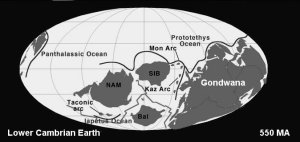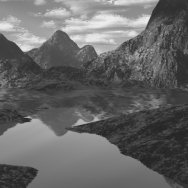Paleozoic Time Geological History
Geological History
|
Also see: Paleobiology of the Paleozoic | |||
|
Cambrian
Time (541
to 485 MA) Ordovician Time (485 to 443 MA) During the Ordovician, oceans separated the continents of Laurentia, Baltica, Siberia and Gondwana. Gondwana contained most land area, and comprised Southern Europe, Africa, South America, Antarctica, and Australia. Throughout the period, Gondwana drifted south. North America lay on the equator and was mainly submerged until the Middle Ordovician. Western and Central Europe were separated and located in the southern tropics. Europe moved southward towards North America. During the Middle Ordovician, uplifts occurred in most of the areas that had been shallow shelf. Such uplists are known to be predictors of forthcoming glaciation. Increased sea floor spreading and ridge activity accompanied by volcanic activity occurred. Ocean currents changed as a result of lateral continental plate motions causing the opening of the Atlantic Ocean. Sea levels underwent regression and transgression globally, causing flooding of the Gondwana craton , inturn causing cessation of carbonate sedimentation. Late in the Ordovician, a major glaciation began. This pervasive global event caused a profound drop in sea level, draining nearly all craton platforms. The end of the Ordovician was one of the coldest times in Earth history. Ice covered much of the southern region of Gondwana. Silurian Time (443 to 419 MA) During the Silurian, Laurentia collided with Baltica closing the northern section of the Iapetus Ocean. This collision was preceded in many places by the abduction of marginal island arcs, resulting in the formation of the Caledonide mountains in Scandinavia, northern Great Britain and Greenland, and the Northern Appalachian mountains of Eastern North America. North China and South China had rifted away from the Indo-Australian margin of Gondwana, drifting North across the Paleo-Tethys Ocean. Throughout the Early and Middle Paleozoic, the expansive Panthalassic Ocean covered much of the northern hemisphere. Surrounding this ocean was a subduction zone, much like the modern "ring-of-fire" that surrounds the Pacific Ocean. Devonian Time (419 to 359 MA) The Devonian realized profound changes in the world's geography. Landmasses were concentrated in two supercontinents, Gondwana and Euramerica. These vast continents close to other in the lower hemisphere, while a vast ocean consumed the remainder of the Earth. These supercontinents were surrounded on all sides by subduction zones. With the development of the subduction zone between Gondwana and Euramerica, a major collision was set in motion that would bring the two together to form the single world-continent Pangea in the Permian. The collision of what is now North America and Europe, causes in huge granite intrusions and the uplifting of the Appalachian Mountains. Erosion of new mountains provided great volumes of sediment hat were deposited in the also and nearby lowlands and shallow seas. Extensive reef building, producing some of the world's largest reef complexes, proceeded as stromatoporoids and corals appeared in increasing numbers. These were built in the equatorial seas between the continents. Large areas of shallow sea in North America, central Asia, and Australia became basins in which great quantities of rock salt, gypsum, and other minerals precipitated. Near the end of the Devonian, a mass extinction event occurred. Glaciation and the lowering of the global sea level may have triggered this crisis, since the evidence suggests warm water marine species were most affected. Meteorite impacts have also been blamed for the mass extinction, or changes in atmospheric carbon dioxide. It is even conceivable that it was the evolution and spread of forests and the first plants with complex root systems that may have altered the global climate. Whatever the cause, it was about this time that the first vertebrates moved onto the land. Carboniferous Time (359 to 299 MA) During the Late Carboniferous Laurussia (comprising what is now Europe and North America) collided with Godwanaland (comprising what is now Africa and South America) producing the Appalachian Mountains belt in Eastern North America and the Hercynian Mountains in the United Kingdom. The collision of Siberia and Eastern Europe created the Ural Mountains. Ice covered much of the southern hemisphere and vast coal swamps formed along the equator in what is now North America. A heavily
marine environment existed in North America during the Lower Carboniferous
as seas submerged parts of the continents. In contrast, North
America during the Upper Carboniferous alternated between terrestrial
and marine domination as seas rose and fell in sequence with glaciation.
These environmental conditions coupled with the vast amount of
plant material produced in prodigious forests set the stage for
the production of vast amounts of coal over succeeding millions
of years. The burial of organically huge organic carbon led, in
turn, to a buildup of oxygen in the atmosphere to levels some
80% higher than today. Additionally, marine strata are more common
in the earlier Carboniferous than the later Carboniferous, and
nearly absent by the latest Carboniferous.
| ||||
Fossil
Museum Navigation:
Home Geological Time Paleobiology Geological History Tree of Life Fossil Sites Fossils Evolution Fossil Record Museum Fossils |


 near the South Pole. Gondwana, the supercontinent that was assembled
during the Pan-African orogeny, was the largest continent, spanning
from the equator to the South Pole. Because of a warmer climate
across the earth, much of the continental coasts as well as
inland
were flooded below shallow seas, a perfect world as it were for
the dramatic radiation of new and complex forms of life during
the
near the South Pole. Gondwana, the supercontinent that was assembled
during the Pan-African orogeny, was the largest continent, spanning
from the equator to the South Pole. Because of a warmer climate
across the earth, much of the continental coasts as well as
inland
were flooded below shallow seas, a perfect world as it were for
the dramatic radiation of new and complex forms of life during
the